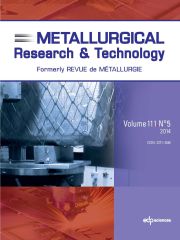Article contents
A molecular dynamics simulation study of semi-solid-state Fe:high temperature elasticity and void formation in liquid
Published online by Cambridge University Press: 30 October 2014
Abstract
Hot tearing defects appear during the last steps of casting solidification of dendrites.The crystalline structure traps a small amount of liquid metal, which is depressed, andcavities are spontaneously initiated. Molecular dynamics (MD) simulations of pure iron areable to predict, on one hand, the high temperature elastic modulus of crystals, and on theother hand, the cavitation event in liquid metal and near the solid-liquid growth front.High values of elastic tensor components are predicted close to the melting temperature.We conclude that a weakening of the mechanical properties of the crystal is not the reasonfor failure initiation. The crystals are thinned by partial melting as the effect ofnegative pressure increases. The cavitation is spontaneously initiated under a very highnegative pressure. The cavity expands very quickly and applies a pressure wave to thethinned crystals. We propose that this crystal thinning/pressure wave coupling is able toinitiate cracks inside the crystal.
Keywords
- Type
- Research Article
- Information
- Copyright
- © EDP Sciences 2014
References
- 2
- Cited by


